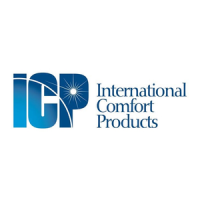10. All horizontal pipe runs MUST be supported at least every
five feet with galvanized strap or other rust resistant materi-
al. NO sags or dips are permitted.
11. All vertical pipe runs MUST be supported every six feet
where accessible.
12. The maximum pipe length is 40' (12m) total in the inlet or
outlet side of the system. Up to five, 90° elbows can be
used on the inlet or the outlet. If more than five elbows are
required, reduce the length of both the inlet and exhaust
pipes 5' (1.5m) for each additional elbow used. (See Vent
Tables).
13. The minimum pipe run length is 2' (.6m).
14. The piping can be run in the same chase or adjacent to sup-
ply or vent pipe for water supply or waste plumbing. It can
also be run in the same chase with a vent from another 90+
furnace.
NOTE: In NO case can the piping be run in a chase where
temperatures can exceed 140° F. or where radiated heat
from adjacent surfaces would exceed 140 ° F.
15. The vent outlet MUST be installed to terminate in the same
atmospheric pressure zone as the combustion air inlet.
16. The vent system can be installed in an existing unused
chimney provided that:
• Both the exhaust vent and air intake run the length of the
chimney.
• No other gas fired appliance or fireplace (solid fuel) is
vented into the chimney.
• The top of the chimney MUST be sealed flush or crowned
up to seal against rain or melting snow so ONLY the piping
protrudes.
• The termination clearances shown in Figure 12 are main-
tained.
17. Horizontal furnace applications with vertical vents requir-
ing vent diameter increaser fittings must have increaser fit-
tings installed in vertical portion of the vent after a 2" elbow
turns upward. Condensate will be trapped in the vent if the
vent diameter is increased prior to having an elbow turned
upward. This could cause nuisance tripping of the pressure
switch. (This does not apply to horizontal venting.)
Piping Insulation Guidelines
NOTE: In general, chimneys on an outside wall and attics are ex-
posed to cold conditions which can cause the vent pipe to sweat
from condensation. This can lead to moisture damage to living
spaces. It is highly recommended that piping in these cases be
insulated to insure proper protection from condensation damage.
Use closed cell, neoprene insulation or equivalent. If Fiberglass
or equivalent insulation is used it must have a vapor barrier. Use R
values of 7 up to 10', R-11 if exposure exceeds 10L If Fiberglass
insulation is used, exterior to the structure, the pipe MUST be
boxed in and sealed against moisture.
1. Insulate pipe when the exhaust vent passes through an un-
conditioned space or raceway.
2.
If situations require pipe to be run on the exterior wall to
reach a suitable termination point, it MUST be properly in-
sulated.
3. If it is necessary to insulate piping when an inactive chim-
ney is used as a chase, the top of the chimney MUST be
sealed flush or crowned up to seal against rain or melting
snow so ONLY the piping protrudes.
4. When the vent or combustion air pipe height above the roof
exceeds 30" (760mm), or if an exterior vertical riser is used
on a horizontal vent to get above snow levels, the exterior
portion MUST be insulated.
5. When combustion air inlet piping is installed above a sus-
pended ceiling, the pipe MUST be insulated with moisture
resistant insulation such as Armaflex or other equivalent
type of insulation.
6. Insulate combustion air inlet piping when run in warm, hu-
mid spaces such as basements.
SizingCombustionAir andVent Pipe
1. Consult Table 4 to select the proper diameter exhaust and
combustion air piping. Exhaust and combustion air piping
is sized for each furnace Btuh size based on total lineal vent
length (on inlet or outlet side), and number of 90° elbows
required.
1. Single Pipe Installation-If installing as a non-direct vent
appliance, (single outlet pipe and no inlet pipe) refer to
Table 3. The table shows the maximum number of elbows
allowed with any given pipe diameter and length of run.
2. Double Pipe Installation-If installing as a direct-vent ap-
pliance, consult Table 4 to select the proper diameter ex-
haust and combustion air piping. Exhaust and combustion
air piping is sized for each furnace Btuh size based on total
lineal vent length (on inlet or outlet side), and number of 90°
elbows required.
2. Use of Elbows-Two 45 ° elbows can be substituted for one
90° elbow. The elbow or elbows used for vent termination
outside the structure ARE counted, including elbows need-
ed to bring termination above expected snow levels.
EXAMPLE: Refer to, 75,000 Btuh Furnace, Table 4.
• Avent system uses 25' of Inlet pipe and 24' of Outlet pipe. Use
the maximum length found in your system, so 25' is the length to
use in these tables.
• There are 4 elbows on the Outlet and 2 elbows on the Inlet. Use
the 4 elbows row because that is the maximum number of elbows
on any one side (Inlet or Exhaust).
• In this example, combinations C or F are allowed. Using the
legend at the bottom of the table, combination C is 3" Inlet with a
21/2'' Exhaust. Combination F is a 3" Inlet with a 3" Exhaust. Ei-
ther combination is allowed together, but they can NOT be mixed.
In other words, part ofa C combination can NOT be used with part
of an F combination just because they are listed together in the
same block.
[_ 440 01 100201

